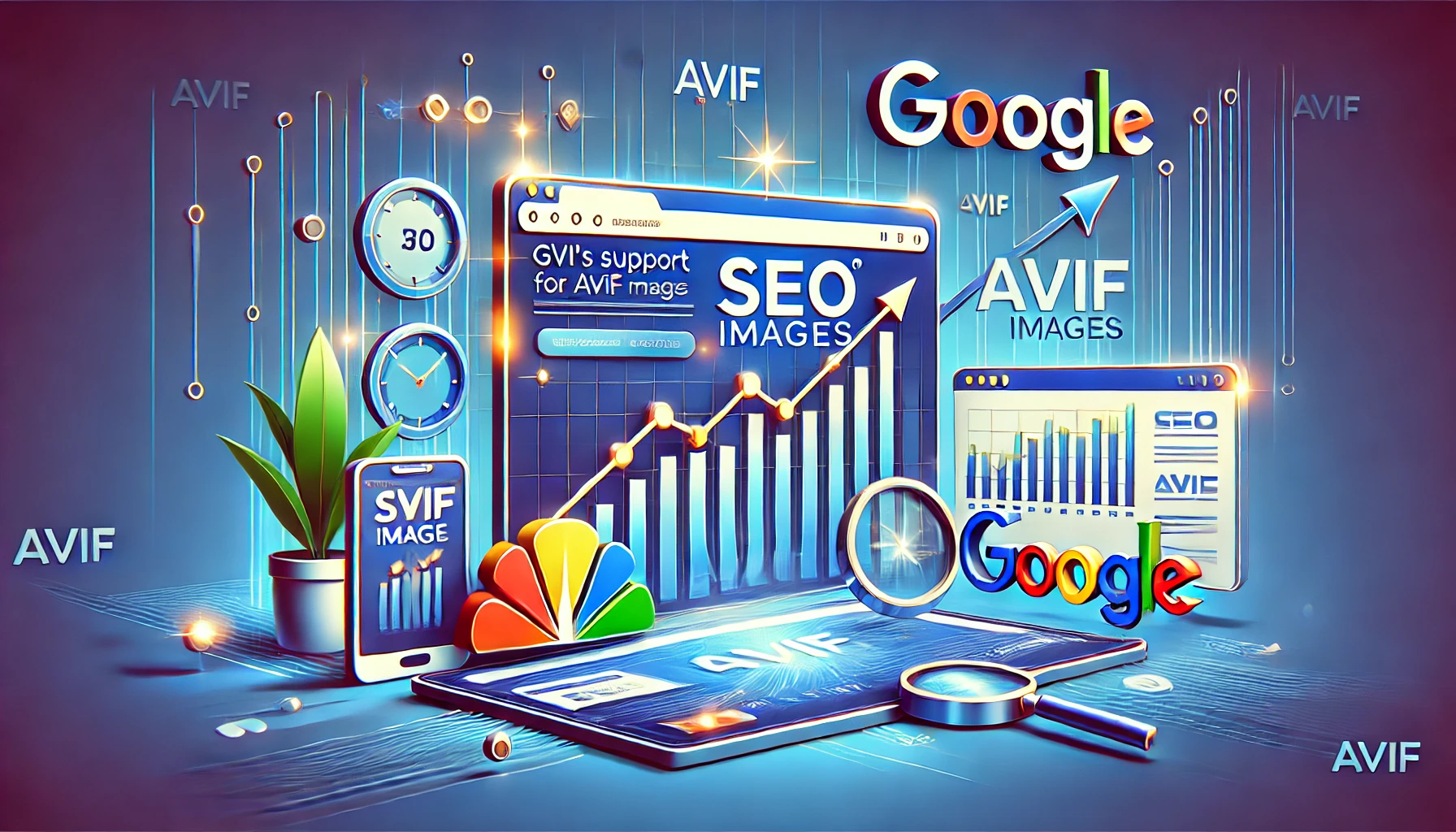How Google Support for AVIF Images in 2024 Could Revolutionize SEO
Google Support for AVIF Images: In the ever-evolving world of digital marketing, staying ahead of the curve is essential for maintaining a competitive edge. One of the latest developments set to impact SEO strategies is Google’s support for AVIF images. As of 2024, Google supports AVIF images, and this change is poised to have a significant impact on how websites perform in search engine rankings. But what exactly does this mean for SEO, and how can you leverage this update to boost your site’s visibility?
In this blog, we’ll explore the implications of Google’s new support for AVIF images, the SEO benefits of using AVIF, and how it compares to other image formats like WebP. By the end of this article, you’ll have a clear understanding of how to use AVIF images to enhance your website’s SEO performance.
Understanding Google’s Support for AVIF Images in 2024
The introduction of Google AVIF support in 2024 marks a significant milestone in the realm of web development and SEO. AVIF (AV1 Image File Format) is a relatively new image format that offers superior compression and quality compared to older formats like JPEG and PNG. This makes it an attractive option for webmasters looking to optimize their websites for speed and performance.
1. What Is AVIF and Why Does It Matter?
AVIF is an image format that uses the AV1 video codec, a royalty-free technology developed by the Alliance for Open Media. AVIF images offer several advantages over traditional image formats, including:
- Superior Compression: AVIF can reduce file sizes by up to 50% compared to JPEG, without sacrificing image quality. This results in faster page load times and improved user experience.
- High-Quality Images: Despite the smaller file size, AVIF images maintain high visual quality, even at low bitrates. This makes it ideal for delivering crisp, detailed images without slowing down your website.
- Support for Advanced Features: AVIF supports features like HDR (High Dynamic Range), 10-bit color depth, and transparency, making it a versatile format for various types of web content.
Google’s decision to support AVIF images is a response to the growing need for faster, more efficient web content. By adopting this format, webmasters can improve their site’s performance, which in turn can boost their search engine rankings.
2. How Google AVIF Support 2024 Impacts SEO
With Google supporting AVIF images, the impact on SEO is significant. Google’s algorithms prioritize websites that offer fast loading times and a positive user experience. Since AVIF images can dramatically reduce load times, they can directly contribute to better SEO performance.
- Faster Load Times: Google has long emphasized the importance of page speed as a ranking factor. By reducing image file sizes, AVIF can help your website load faster, which can lead to higher rankings in search results.
- Improved Mobile Experience: With more users accessing the web via mobile devices, optimizing for mobile performance is crucial. AVIF images help ensure that your website loads quickly on mobile, improving user engagement and reducing bounce rates.
- Better Image Quality: High-quality images enhance user experience and can increase the time visitors spend on your site. By using AVIF, you can deliver visually appealing content without compromising on speed.
As Google continues to evolve its algorithms, formats like AVIF that prioritize speed and quality will likely play an increasingly important role in SEO strategies.
Why AVIF Images Are a Game-Changer for SEO
The introduction of AVIF images presents a significant opportunity for webmasters and SEO professionals alike. But what exactly are the SEO benefits of AVIF images, and how can they help your website climb the search engine rankings?
1. SEO Benefits of AVIF: Enhanced Speed and Performance
One of the most compelling reasons to adopt AVIF images is the potential for enhanced speed and performance. In the context of SEO, speed is crucial. Google’s algorithms favor websites that load quickly, and slow load times can lead to higher bounce rates and lower rankings.
- Compression Efficiency: AVIF’s superior compression means that you can significantly reduce the file size of images on your site without losing quality. This can lead to faster load times, which can improve your SEO performance.
- Reduced Bandwidth Usage: Smaller file sizes also mean reduced bandwidth usage, which can be particularly beneficial for users with limited data plans or slower internet connections. This can lead to a better overall user experience, which is a key factor in SEO.
- Optimized for Modern Browsers: As more browsers support AVIF, including Chrome, Firefox, and Edge, the format’s adoption is expected to grow. This widespread support ensures that your site’s images will be displayed correctly across different devices and browsers, further enhancing user experience.
2. How AVIF Format SEO Impact Can Improve Your Rankings
The AVIF format SEO impact extends beyond just speed. High-quality images that load quickly can lead to improved user engagement, which is another important factor in SEO. Here’s how AVIF can help:
- Lower Bounce Rates: Fast-loading pages with high-quality images are more likely to keep visitors engaged. Lower bounce rates signal to Google that your content is relevant and valuable, which can boost your rankings.
- Increased Dwell Time: Users who find your content visually appealing and easy to navigate are more likely to stay on your site longer. Increased dwell time is another positive signal to Google, indicating that your site offers a good user experience.
- Higher Conversion Rates: Whether your goal is to drive sales, generate leads, or increase sign-ups, fast-loading, high-quality images can lead to higher conversion rates. This not only benefits your SEO but also contributes to your overall business objectives.
By understanding and leveraging the SEO benefits of AVIF, you can enhance your site’s performance and improve your search engine rankings.
AVIF vs. WebP: Which Image Format Offers Better SEO Performance?
As you consider incorporating AVIF images into your website, you might wonder how they compare to other modern image formats, such as WebP. Both formats offer advantages over traditional formats like JPEG and PNG, but which one is better for SEO?
1. Comparing AVIF vs WebP SEO Performance
When it comes to AVIF vs WebP SEO, both formats offer significant advantages, but there are key differences to consider:
- Compression and Quality: AVIF generally offers better compression than WebP, meaning smaller file sizes for the same quality. This can result in faster load times and better SEO performance. However, WebP also provides excellent compression and quality, making it a strong contender.
- Browser Support: WebP has been around longer and is supported by a wider range of browsers. While AVIF support is growing, it’s not yet as widespread. However, with Google’s backing, AVIF adoption is expected to increase rapidly.
- Features: AVIF supports advanced features like HDR and 10-bit color, which are not available in WebP. If your site relies on high-quality visuals, AVIF might be the better choice.
Ultimately, the choice between AVIF and WebP may come down to your specific needs and the types of content you’re hosting. Both formats can improve SEO, but AVIF’s superior compression and advanced features make it particularly appealing for future-proofing your site.
2. Implementing AVIF Images for SEO Optimization
If you decide to adopt AVIF images for your website, it’s important to implement them correctly to maximize their SEO benefits. Here are some tips:
- Use Modern Browsers: Ensure that your website is optimized for browsers that support AVIF, including Chrome, Firefox, and Edge. You can also provide fallback options like WebP or JPEG for browsers that don’t support AVIF yet.
- Optimize Image Settings: When converting images to AVIF, use tools that allow you to adjust compression settings to balance quality and file size. This ensures that your images look great while still loading quickly.
- Monitor Performance: Use tools like Google PageSpeed Insights or Lighthouse to monitor the impact of AVIF images on your site’s performance. Adjust your strategy as needed to ensure optimal results.
By carefully implementing AVIF images, you can take full advantage of the AVIF image SEO benefits and ensure that your site remains competitive in search engine rankings.
Leveraging AVIF Images for SEO Success
As Google continues to support new technologies that enhance the user experience, staying ahead of these changes is crucial for maintaining a strong SEO strategy. The AVIF format SEO impact is a prime example of how adopting the latest advancements can give your website an edge.
By integrating AVIF images for SEO, you can improve your site’s load times, enhance the user experience, and ultimately boost your search engine rankings. Whether you’re choosing between AVIF vs WebP SEO or exploring how to implement AVIF images on your site, the potential benefits are clear.
As we move into 2024 and beyond, Google AVIF support 2024 will likely become a standard consideration for web developers and SEO professionals alike. By staying informed and proactive, you can ensure that your website remains optimized for the future.
For more insights on optimizing your website for SEO, check out the resources available at Regent Studies. With the right strategies in place, you can stay ahead of the curve and achieve lasting SEO success.




